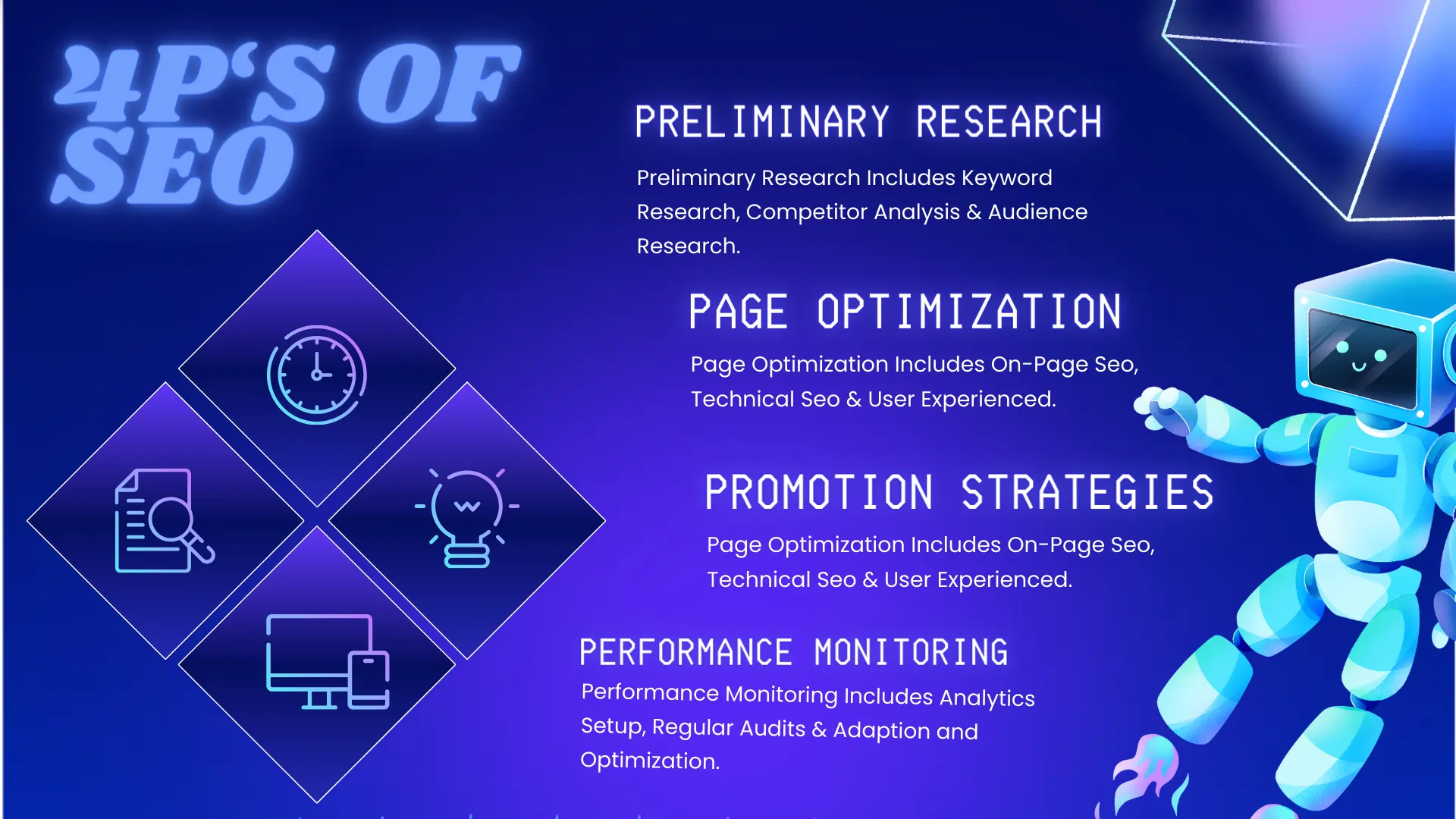What are the 4Ps of SEO?

What are the 4Ps of SEO?
Introduction:
4Ps of SEO In the ever-evolving landscape of digital marketing, understanding the fundamental principles of Search Engine Optimization is paramount. Just like the traditional 4Ps of marketing (Product, Price, Place, and Promotion), Search Engine Optimization has its own set of 4Ps that serve as a blueprint for achieving online visibility, driving organic traffic, and securing a strong position in search engine results.
1. Preliminary Research
Keyword Research
– SEO starts with in-depth keyword research. Identify and analyze keywords relevant to your business, products, or services. Tools like Google Keyword Planner, SEMrush, or Ahrefs can aid in understanding search volumes, competition, and user intent.
– Strategic keyword selection is the cornerstone of successful SEO, ensuring your content aligns with what your target audience is actively searching for.
For Example:
• Long-Tail Keywords: Consider targeting long-tail keywords for niche-specific content. These longer, more specific phrases often have lower competition and can attract highly targeted traffic.
• Intent Analysis: Go beyond search volume and understand user intent. Are users looking for information, products, or solutions? Tailor your content accordingly.
Competitor Analysis
– Analyze competitors’ SEO strategies to identify strengths, weaknesses, and opportunities. This insight helps in crafting a unique and competitive approach.
– Understanding the competitive landscape allows you to position your content effectively and identify areas for improvement in your SEO strategy.
For Example:
• Backlink Analysis: Examine competitors’ backlink profiles to identify opportunities for acquiring similar high-quality links.
• Content Gap Analysis: Identify topics your competitors have covered extensively and explore opportunities to create more comprehensive or unique content.
Audience Research
– Know your audience inside out. Understand their preferences, pain points, and search behaviors. Tailor your content to resonate with your target demographic.
– By aligning your content with your audience’s needs, you enhance user engagement and increase the likelihood of your website satisfying user queries.
2. Page Optimization
On-Page SEO
– Optimize individual pages for search engines by incorporating target keywords into titles, headers, meta descriptions, and content.
– Create high-quality, relevant, and engaging content that not only caters to search engine algorithms but also provides value to your audience.
For Example:
• Semantic SEO: Use related terms and synonyms to make your content more semantically rich. This helps search engines understand the context of your content.
• Structured Data Markup: Implement structured data to provide search engines with additional context about your content, potentially leading to rich snippets in search results.
Technical SEO
– Ensure your website is technically sound. Focus on aspects like site speed, mobile responsiveness, and proper URL structures.
– Technical SEO ensures search engines can crawl and index your site efficiently, contributing to improved visibility in search results.
User Experience
– A positive user experience is integral to SEO success. Prioritize user-friendly navigation, clear calls-to-action, and a visually appealing design.
– Search engines reward websites that provide a seamless and enjoyable experience for users.
For Example:
• Mobile-First Design: Prioritize mobile responsiveness to cater to the increasing number of users accessing websites from mobile devices.
• Page Speed Optimization: Optimize images, leverage browser caching, and employ content delivery networks (CDNs) to enhance page load times.
3. Promotion Strategies
Link Building
– Develop a robust backlink strategy by acquiring high-quality, authoritative backlinks from reputable websites.
– Backlinks act as digital endorsements, signaling to search engines that your content is credible and valuable.
For Example:
• Relationship Building: Foster relationships with influencers and industry leaders. Genuine connections can lead to natural backlink opportunities.
• Guest Posting: Contribute high-quality content to authoritative websites within your industry, including a backlink to your site.
Social Media Integration
– Leverage social media platforms to promote your content and engage with your audience. Social signals indirectly impact Search Engine Optimization.
– Social media serves as a valuable distribution channel, amplifying your content to a broader audience.
For Example:
• Platform Selection: Choose social media platforms based on your audience demographics. Visual content may perform well on Instagram, while professional content may thrive on LinkedIn.
• Engagement Strategies: Encourage social sharing and engagement through contests, polls, and interactive content.
Content Distribution
– Share your content through various channels, including email newsletters, industry forums, and relevant online communities.
– Increased visibility through content distribution enhances the likelihood of attracting organic links and improving your website’s authority.
For Example:
• Email Marketing: Utilize email newsletters to distribute your latest content to your subscribers.
• Online Communities: Engage in relevant online forums and communities, sharing valuable insights and content without being overly promotional.
4. Performance Monitoring and Analysis
Analytics Setup
– Implement analytics tools like Google Analytics to track key metrics such as organic traffic, bounce rates, and conversion rates.
– Regularly monitor analytics to gain insights into your website’s performance and identify areas for improvement.
For Example:
- Event Tracking: Implement event tracking in Google Analytics to monitor specific user interactions, such as form submissions and video views.
- Conversion Tracking: Set up conversion tracking to measure the success of specific goals, whether it’s a sale or a sign-up.
Regular Audits
– Conduct periodic Search Engine Optimization audits to identify technical issues, broken links, and areas for optimization. Address issues promptly to maintain a healthy website.
– Audits contribute to the ongoing refinement of your SEO strategy, ensuring it remains aligned with best practices.
For Example:
- Technical Audits: Use tools like Screaming Frog to identify technical issues such as broken links, duplicate content, or crawl errors.
- Content Audits: Evaluate the performance of existing content, identifying opportunities for improvement, consolidation, or updates.
Adaptation and Optimization
– Search Engine Optimization is a dynamic field. Continuously adapt your strategy based on performance data and industry trends.
– Test and refine your approach, adjusting keywords, content, and technical elements to stay ahead of the curve.

Conclusion:
The 4Ps of SEO provide a comprehensive framework for navigating the intricacies of search engine optimization. By conducting thorough Preliminary Research, optimizing individual pages effectively, employing strategic Promotion Strategies, and regularly monitoring Performance, your Search Engine Optimization efforts can yield sustainable and meaningful results. Regularly reassess and refine your strategies to stay ahead in the ever-evolving digital landscape, ultimately securing a prominent position in search engine results.
Partnered with Naumaan Oman
Recent Posts
Working Together Ideas come to life
No matter how big your company is, as you expand and reach new highs you’ll want an agency to have your back. One with a process
360presence@gmail.com

© 2023 360PRESENCE All rights Reserved
















